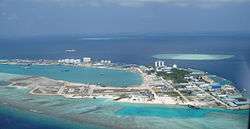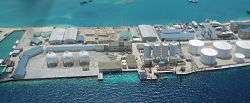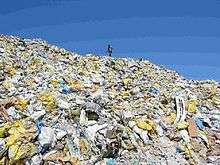Thilafushi
| Thilafushi | |
|---|---|
| Inhabited island | |
 Thilafushi Location in Maldives | |
| Coordinates: 4°11′N 73°26′E / 4.183°N 73.433°ECoordinates: 4°11′N 73°26′E / 4.183°N 73.433°E | |
| Country | Maldives |
| Administrative atoll | Kaafu Atoll |
| Distance to Malé | 6.85 km (4.26 mi) |
| Dimensions | |
| • Length | 3.50 km (2.17 mi) |
| • Width | 0.20 km (0.12 mi) |
| Time zone | UTC+05:00 (MST) |
Thilafushi (Dhivehi: ތިލަފުށި) is an artificial island created as a municipal landfill situated to the west of Malé, and is located between Kaafu Atoll's Giraavaru and Gulhifalhu of the Maldives.
History

Thilafushi originally was a lagoon called "Thilafalhu" with a length of 7 km and a width of 200 metres at the shallowest regions. It came into existence following a series of discussions and efforts to resolve Malé's garbage predicament during the early 1990s. The decision to reclaim Thilafalhu as a landfill was made on December 5, 1991.
Thilafushi received its first load of garbage from Malé on January 7, 1992. Operations started with just 1 landing craft, 4 heavyload trucks, 2 excavators and a single wheel loader.
During its early years of waste disposal operations, pits (also known as cells) with a volume of 37,500 ft3 (1060 m3) were dug, after which the sand obtained from the excavation was used to construct walled enclosures around the internal perimeter of the cells. Waste received from Malé was deposited into the midst of the pit, which was topped off with a layer of construction debris and then uniformly levelled with white sand. Initially there was no segregation of the waste since it had to be disposed immediately due to mass accumulation.
Industrialization

Today Thilafushi has a landmass of more than 4.6 million ft2 (0.43 km²). The speedy terrestrial growth of Thilafushi was observed by the Government, and in November 1997, it was decided that land was to be leased to entrepreneurs interested in acquiring land for industrial purposes. Initially there were just 22 lease holders. Within the past 10 years, this number has doubled to 54 resulting in more than 1.2 million square feet (0.11 km² or 27.5 acres) of land being used currently, which generates an excess of 14 million Rufiyaa (about USD1,000,000.00) per annum. Soon after, an area of 0.2 km² (known as Thilafushi-2) was reclaimed using white sand as the filling material to provide terra firma for the more heavy industries.
The current (major) industrial activities in the island are boat manufacturing, cement packing, methane gas bottling and various large scale warehousing. The government is also planning a 50-ton incinerator facility. [1]
In March 2015 the Maldivian government decided to relocate the central commercial port from Malé to Thilafushi. [2] However the deal was not completed.[3]
Environmental issues
Environmentalists say that more than 330 tonnes of rubbish is brought to Thilafushi a day, most of which comes from Malé. In 2005 it was estimated that 31,000 truckloads of garbage are transported to Thilafushi annually, where it is dumped in large piles and eventually used to reclaim land and increase the size of the island.[5] So much is being deposited that the island is growing at a square metre a day.[6]
According to official statistics, a single tourist produces 3.5kg of garbage a day, twice as much as someone from Malé and five times more than anyone from the rest of the Maldives archipelago. Altogether, that comes to "300 to 400 tons of trash" dumped on the island every day, according to Shina Ahmed, administration manager of the Thilafushi Corporation that runs the island.[7]
Ali Rilwan, an environmentalist in Malé, said that "used batteries, asbestos, lead and other potentially hazardous waste mixed with the municipal solid wastes being put into the water. Although it is a small fraction of the total, these wastes are a source of toxic heavy metals and it is an increasingly serious ecological and health problem in the Maldives".[6][8] Bluepeace, the main ecological movement of the Maldives, has described the island as a "toxic bomb".[9]
In December 2011 the Malé City Council temporarily banned the transporting of waste to Thilafushi because of a surge in waste floating in the island's lagoon and drifting out to sea.[10][11][12] The cause of the floating waste has been blamed on "impatient" boat captains unable to unload their waste.[13][14]
In a BBC report in May 2012, the island of waste was described as "apocalyptic".[15][16]
See also
References
- ↑ "Greater Malé Industrial Zone spawns new construction and logistics backbone". The Business Report. Retrieved 10 September 2018.
- ↑ Government signs MoU with Dubai Ports World Archived 25 March 2015 at the Wayback Machine. Minivan News, 23 March 2015.
- ↑ "No deal with DP World on Thilafushi port project - Maldives Independent". maldivesindependent.com.
- ↑ "IFRC.org - IFRC". www.ifrc.org.
- ↑ Tsunami leaves garbage problems for atoll nation The International Federation of Red Cross and Red Crescent Societies (IFRC), 2 May 2005.
- 1 2 Paradise lost on Maldives' rubbish island Guardian, 3 January 2009.
- ↑ Maldives: Idyllic Archipelago's Unprecedented Floating Trash Dump Le Monde/Worldcrunch, 11 May 2012.
- ↑ Maldives 'rubbish island' turns paradise into dump (Photographs by Elin Høyland) Guardian, 3 January 2009.
- ↑ "THILAFUSHI: TOXIC BOMB IN THE OCEAN". www.bluepeacemaldives.org.
- ↑ Thilafushi closed for clean-up as ‘garbage island’ overflows Minivan News, 6 December 2011.
- ↑ Maldives 'Rubbish Island' is 'overwhelmed' by garbage BBC News Asia, 8 December 2011.
- ↑ Garbage floats off Thilafushi Haveeru Online, 6 September 2011.
- ↑ Garbage floats freely from “impatient” boats Minivan News, 8 September 2011.
- ↑ Resort garbage dumped into lagoon Haveeru Online, 5 December 2011.
- ↑ 'Apocalyptic' floating island of waste in the Maldives BBC News Asia, 20 May 2012.
- ↑ Simon Reeve visits an island of rubbish. BBC TWO. Wednesday 25 April 2012.
Further reading
![]()
- Dina Spector (9 March 2013). "This Island Is A Toxic Bomb In The Center Of Paradise". Business Insider. Retrieved 11 March 2013.
